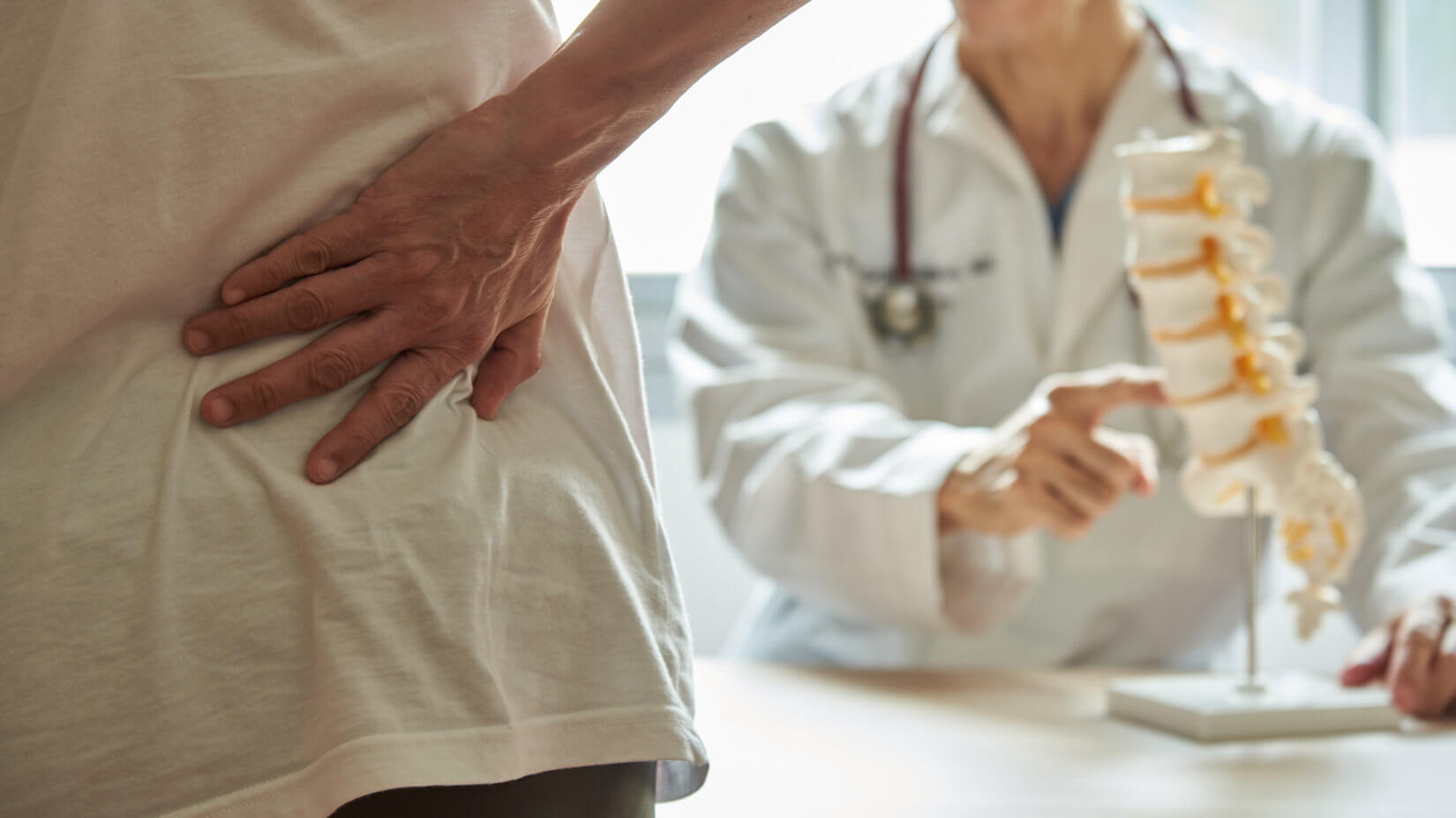Back pain is a very common problem, which sooner or later affects everyone. According to some data, 90% of people experience back pain at least once in their lives. In most cases, back pain fades away in 2–3 weeks, and we never learn what caused it. Sometimes, back pain can become chronic and turn into a disease. Treatment of chronic pain is complicated and long-term.
What causes back pain?
Back pain may originate in various structures in the spine: muscles and tendons, ligaments, joints, bones and periosteum, intervertebral discs or nerve structures. Most often, back pain is caused by weakened muscles and degradation of small joints of the vertebrae and intervertebral discs. Another common cause of back pain is pressure on nerve roots due to displaced intervertebral discs (herniated disk). Rarely, back pain is caused by problems with the internal organs, tumours or inflammatory processes. In most patients, the exact cause of back pain cannot be determined.

What triggers back pain?
Back pain is usually caused by lifting heavy objects, making a sudden awkward movement, and increasingly by stress, a close companion of our modern fast-paced lives. Stress causes tension in back muscles and can trigger or worsen back pain. This may lead to a vicious circle of pain triggering worrying, and worrying triggering stress, which in turn contributes to the pain worsening.
What worsens back pain?
These are some of the factors that can worsen back pain: sitting for prolonged periods of time, driving or lying down, lifting heavy objects, using low, soft seats and beds, poor posture and obesity.
Do I have to see a doctor for my back pain?
SHORT-TERM PAIN
When back pain is short-term, you don’t usually have to see a doctor. Use hot or cold compresses or non-prescription analgesics. Some analgesics have anti-inflammatory properties, which means they can successfully relieve pain and alleviate inflammation. Nalgesin S* is a highly effective analgesic. If you decide to take analgesics, it is recommended you take them regularly and not only when your pain gets too intense. Regular use of analgesics contributes to better pain management. It is important to stay active as much as possible in order not to lose muscle mass. Massage has a therapeutic effect, as well as exercises for stretching and strengthening your muscles.
LONG-TERM INTENSIVE PAIN
When pain becomes intense or does not subside after several weeks, you should visit your doctor. Seek medical attention immediately if you sense numbness in your groin area or in your legs, if you experience instability when standing up or problems when moving your legs, or if you have difficulty urinating and defecating. Your doctor may order additional diagnostic procedures, physiotherapy, surgery, or prescribe analgesics. As pain can be caused by different factors, and its intensity and duration may vary, your doctor will select the analgesics most suitable for you.
Prevention is better than cure
Back pain can be prevented in different ways.
- Exercise regularly. Make sure you include exercises for relaxing and strengthening back muscles into your routine.
- Maintain normal weight.
- Pay attention to your posture, how you sit at home, at work or behind the wheel.
- Be careful when lifting heavy objects – make sure you do it with your back straight.
Interesting facts about back pain
- Back pain is most prevalent in the 35- to 55-year-age groups.
- Between 2% and 8% of people who suffer from back pain develop chronic pain.
- Resting is not recommended for those affected by back pain – it is better to stay active.
- Back pain is the fifth most common reason for individuals to seek medical attention.
- Uncomfortable shoes contribute to poor posture, and wearing too high heels may increase your back problems.
Back pain is a very common problem that generally lasts between 2 and 3 weeks. When the pain starts, its alleviation depends on its intensity and duration. If the pain is mild, you can ask your pharmacist about non-prescription analgesics. If the pain is strong and lasts a longer period of time, you should visit your doctor.
* Krka has registered a wide range of products in different countries. There are differences in registration and availability of our products among the countries.
Some products may also have a different brand name in different countries. Please contact your local representative office for up-to-date details specific to your country or visit the available Krka’s local web pages.
References
- Bolečine v križu [internet]. eZdravje [cited29.6.2021].
Dostopno na naslovu: https://www.ezdravje.com/bolecina/bolecine-v-krizu/?s=vse - Factsheet: The Global Burden of Low Back Pain [internet]. International Association for the Study of Pain, 2021. [cited 24.2.2021].
Accessible at: http://s3.amazonaws.com/rdcms-iasp/files/production/public/Global%20Year%202021_Global%20Burden%20of%20LBP%20Fact%20Sheet.pdf. - Friedly J, Standaert C, Chan L. Epidemiology of Spine Care: The Back Pain Dilemma. Phys Med Rehabil Clin N Am. 2010 Nov; 21(4): 659–677.
- Patel AT, Ogle AA. Diagnosis and management of acute low back pain. Am Fam Physician. 2000;61(6):1779-86, 1789-90.
- Bolečina: Sedaj jo lahko izmerite! [internet]. SZZB [cited 29.6.2021].
Accessible at: https://www.merjenjebolecine.si/ukrepi_pri_bolecini_v_hrbtenici_in_krizu.html - Low Back Pain and Sciatica [internet]. Medscape; 2018 [cited 29.6.2021].
Accessible at: https://emedicine.medscape.com/article/1144130-overview - Prevent Back Pain [internet]. My Healthfinder; 2021 [cited 29.6.2021].
Accessible at: https://health.gov/myhealthfinder/topics/everyday-healthy-living/safety/prevent-back-pain - Nalgesin S [internet]. Krka. [cited 18.6.2021].
Accessible at: https://www.nalgesin.com/si/nalgesin-s/
